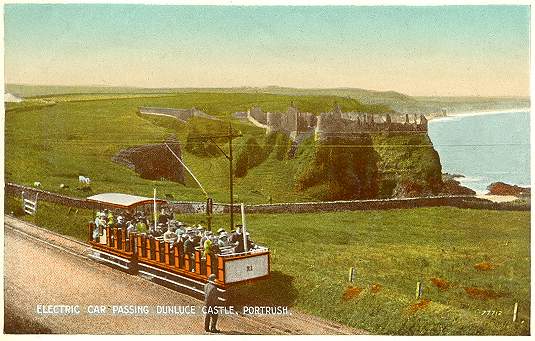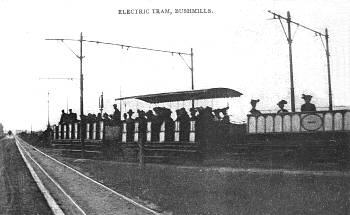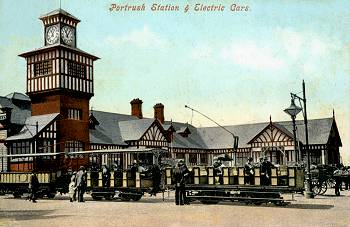

The year 2008 marked 125 years since the opening of the Giant's Causeway, Portrush and Bush Valley Tramway in County Antrim, Northern Ireland. Our main view is from postcard 77712 in the "Carbo Colour" series from Valentine & Sons of Dundee. It shows toastrack motor car 21 with a roofed toastrack trailer passing Dunluce Castle near Portrush in about 1914. The castle was built in about 1300 and was occupied until 1639 when it was said the kitchen and servants fell into the sea.
At around 9 miles long, the Giant's Causeway Tramway was one of the pioneer electric lines in the world. The company was set up on 26th August 1880 by local brothers, William Atcheson Traill and Anthony Traill. As the line was originally envisaged as being electrically powered, Siemens Brothers of London were appointed electrical engineers to the company, with Dr Edward Hopkinson as their representative. Since the electric principle was still experimental, the first section from Portrush to Bushmills (home of what is claimed to be the world's oldest whiskey distillery) was opened on 29th January 1883 using two Wilkinson steam trams. Although mostly 3 foot gauge single sleeper-track with passing loops, the end section used street running and steam would be required there and for goods traffic in any case. At first a two rail system with iron-tyred wood insulated wheels was tried, with a steam driven dynamo in the depot at Portrush. Due to current leakage this was soon replaced by a raised third rail 18 inches above and to the outside of the running rails, with power supply from a hydro-electric generating station at Walkmill Falls, Bushmills, making this the world's first hydro-electric powered railway.
It is said that on 16th April 1883, with the breakdown of a steam tram loco, the first passengers were carried by an electric car in public service, but the official opening of the electric line did not take place until 28th September, with regular electric service beginning on 5th November. This is why there is some debate as to whether this line or the Volk's Railway at Brighton (opened 4th August 1883) was the first line in Britain to use electric traction. The extension from Bushmills to the Giant's Causeway was opened on 1st July 1887. The Traills stated that at 250 volts any electric shock would be slight, but in 1884 the Irish Times reported that a man had stood on the live rail to mount his horse and that although the man was unhurt, the horse received a fatal shock. On 26th August 1895, cyclist Thomas Walsh was killed by an electric shock after touching the conductor rails, with Major Cardew reporting to the Board of Trade recommending the removal of the third rail on roadside sections. The third rail was replaced on 26th July 1899 by overhead electric wire using under-running trolleys with side poles throughout the whole line and use of the steam trams mostly ceased. The original line voltage varied at around the 290-310 volt D.C. mark, reduced to 200 after the accident. After the overhead conversion and upgrading of the Bushmills generating station to 90 horsepower in 1907, the voltage was raised to 550.
 The rolling stock was quite a mixture. Two additional steam trams were added in 1886 and 1897. The original two were scrapped in 1898 and 1908, but the two newer ones survived until the 1920s although were little used. The initial trailers and power cars were built by the Midland Railway Carriage and Wagon Company Limited of Shrewsbury, presumably with Siemens electrical equipment. Some cars were toastracks, others enclosed. Later cars came from other manufacturers with GEC and Peckham equipment with a number of cars being built by the company themselves. Motor car 21 in our main postcard view dates from 1899 and was built by the Company. A roof and windscreen were later added to it. A number of trailers were conversions from open wagons. One such is shown at Bushmills in the small view, which is from a card published about 1905 by R. A. Halle of Bushmills and printed in Belgium. In all there were 24 passenger vehicles in the fleet, all single deck, the last being cut down from a double-decker bought from Dunfermline in 1937. The fleet livery was red and cream.
The rolling stock was quite a mixture. Two additional steam trams were added in 1886 and 1897. The original two were scrapped in 1898 and 1908, but the two newer ones survived until the 1920s although were little used. The initial trailers and power cars were built by the Midland Railway Carriage and Wagon Company Limited of Shrewsbury, presumably with Siemens electrical equipment. Some cars were toastracks, others enclosed. Later cars came from other manufacturers with GEC and Peckham equipment with a number of cars being built by the company themselves. Motor car 21 in our main postcard view dates from 1899 and was built by the Company. A roof and windscreen were later added to it. A number of trailers were conversions from open wagons. One such is shown at Bushmills in the small view, which is from a card published about 1905 by R. A. Halle of Bushmills and printed in Belgium. In all there were 24 passenger vehicles in the fleet, all single deck, the last being cut down from a double-decker bought from Dunfermline in 1937. The fleet livery was red and cream.
 By the mid 1920s custom had begun a slow decline due to the increase in motor bus and coach traffic, and the line was worked in summer only. The tramway struggled on but the decline continued with the line finally closing on 30th September 1949. Three Giant's Causeway trams have survived. Tram and trailer 2 and 5 are restored as static exhibits in the Ulster Folk and Transport Museum, Cultra, Belfast, Northern Ireland. Motor car 9 is under restoration at the National Museum of Transport at Howth Castle, near Dublin, Ireland. Since 2002 a tourist steam railway has operated on a small part of the original tramway route. Our final small view shows Portrush station about 1905 and is from an unknown publisher.
By the mid 1920s custom had begun a slow decline due to the increase in motor bus and coach traffic, and the line was worked in summer only. The tramway struggled on but the decline continued with the line finally closing on 30th September 1949. Three Giant's Causeway trams have survived. Tram and trailer 2 and 5 are restored as static exhibits in the Ulster Folk and Transport Museum, Cultra, Belfast, Northern Ireland. Motor car 9 is under restoration at the National Museum of Transport at Howth Castle, near Dublin, Ireland. Since 2002 a tourist steam railway has operated on a small part of the original tramway route. Our final small view shows Portrush station about 1905 and is from an unknown publisher.
![]() Go to Postcard Of The Month Index
Go to Postcard Of The Month Index